| کد مقاله | کد نشریه | سال انتشار | مقاله انگلیسی | نسخه تمام متن |
|---|---|---|---|---|
| 4532701 | 1626180 | 2011 | 19 صفحه PDF | دانلود رایگان |

Two research cruises (CIMAR 13 Fiordos) were conducted in the N–S oriented macrobasin of the Moraleda Channel (42–47°S), which includes the E–W oriented Puyuhuapi Channel and Aysen Fjord, during two contrasting productive seasons: austral winter (27 July–7 August 2007) and spring (2–12 November 2007). These campaigns set out to assess the spatio-temporal variability, defined by the local topography along Moraleda Channel, in the biological, physical, and chemical oceanographic characteristics of different microbasins and to quantify the carbon budget of the pelagic trophic webs of Aysen Fjord.Seasonal carbon fluxes and fjord-system functioning vary widely in our study area. In terms of spatial topography, two constriction sills (Meninea and Elefantes) define three microbasins along Moraleda Channel, herein the (1) north (Guafo-Meninea), (2) central (Meninea-Elefantes), and (3) south (Elefantes-San Rafael Lagoon) microbasins. In winter, nutrient concentrations were high (i.e. nitrate range: 21–14 μM) and primary production was low (153–310 mgC m−2 d−1), suggesting that reduced light radiation depressed the plankton dynamics throughout Moraleda Channel. In spring, primary production followed a conspicuous N–S gradient, which was the highest (5167 mgC m−2 d−1) in the north microbasin and the lowest (742 mgC m−2 d−1) in the south microbasin. The seasonal pattern of the semi-enclosed Puyuhuapi Channel and Aysen Fjord, however, revealed no significant differences in primary production (∼800 mgC m−2 d−1), and vertical fluxes of particulate organic carbon were nearly twice as high in spring as in winter (266 vs. 168 mgC m−2 d−1).At the time-series station (St. 79), the lithogenic fraction dominated the total sedimented matter (seston). The role of euphausiids in the biological carbon pump of the Patagonian fjords was evident, given the predominance of zooplankton fecal material, mostly euphausiid fecal strings (46% of all fecal material), among the recognizable particles contributing to the particulate organic carbon flux.The topographic constriction sills partially modulated the exchange of oceanic waters (Subantarctic Surface Water) with freshwater river discharges along the Moraleda Channel. This exchange affects salinity and nutrient availability and, thus, the plankton structure. The north microbasin was dominated by a seasonal alternation of the classical (spring) and microbial (winter) food webs. However, in the south microbasin, productivity was low and the system was dominated year-round by large inputs of glacier-derived, silt-rich freshwater carrying predominantly small-sized diatoms (Skeletonema spp) and bacteria. When superimposed upon this scenario, highly variable (seasonal) solar radiation and photoperiods could exacerbate north–south differences along Moraleda Channel.
Journal: Continental Shelf Research - Volume 31, Issues 3–4, 1 March 2011, Pages 225–243